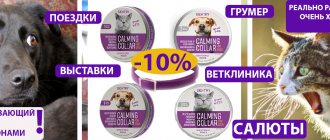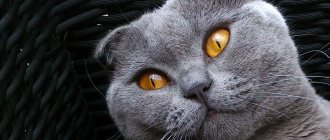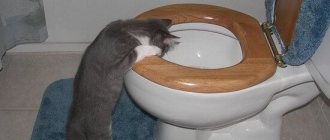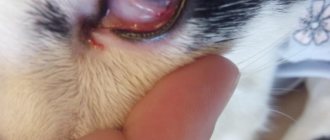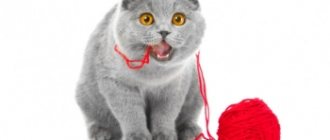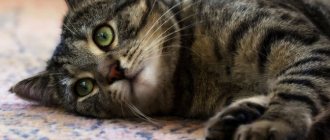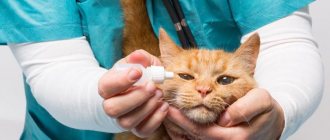Rapid breathing - normal variants
The normal breathing rate of a pet ranges from 20 to 40 breaths per minute. If a cat begins to breathe with greater intensity, this does not mean that he is necessarily ill. Often the reasons for such changes in breathing are:
- overexcitement, fear or rage;
- travel in any transport;
- being in an unfamiliar place;
- visiting a veterinary clinic and taking medications;
- physiological changes in the cat’s body (estrus, pregnancy, childbirth);
- active games, walks, exercise, etc.;
- the process of eating food;
- overheat.
All of the above does not pose a danger to your pet. Usually after some time (after finishing the game, normalizing the emotional state, finishing eating, etc.), breathing is restored.
Associated symptoms
When a cat is brought to the doctor, first of all he asks about the signs that alerted the owner of the animal
Therefore, monitoring a presumably sick pet before visiting the clinic is very important. This helps to quickly make a diagnosis
Signs that accompany the development of pathology of the respiratory system are:
- poor appetite;
- wheezing when breathing;
- increased heart rate;
- elevated temperature;
- rapid pulse;
- redness or bluish tint of the mucous membranes;
- vomit;
- swelling;
- diarrhea;
- the appearance of mucous discharge from the mouth or nasal openings.
The effectiveness of treatment for your pet depends on the amount of time that has passed since the onset of alarming symptoms. There are diseases that develop very quickly. For example, pulmonary edema. Delay in such cases can cost the pet’s life.
When should you worry?
If you notice that the cat is inhaling air suspiciously often, while he may open his mouth slightly and stick out his tongue, then measures should be taken and a qualified specialist will help in this situation. Most likely, the furry will be diagnosed with pathological processes in the respiratory organs. It is possible that the diagnosis will reveal a disease that is not directly related to the respiratory system.
Feline health problems that lead to rapid breathing:
- Diseases of the throat and trachea (edema, paralysis, collapse, oncology, etc.).
- Pathological processes in the bronchi (helminthic infestations, bronchitis, asthma). Then the pet will additionally have a dry cough and fever.
- Pathologies of the nose in cats (inflammatory processes, infections). When a purr, along with rapid breathing, wheezing and discharge from the nose are observed.
- Lung diseases (blockage due to a large number of worms, oncology, edema, inflammation).
- Abundance of air in the chest.
- Hernias in the diaphragm.
- Neoplasms in the breast with changes in the diameter of the lymph nodes.
- Heart problems (any heart failure, arrhythmias).
- Intoxication.
- Diseases of the endocrine system, hormonal imbalances.
- Anemia.
- State of shock.
- Fever.
- Dehydration or severe overheating.
If, in addition to rapid breathing, you find that your beloved cat has begun to behave suspiciously, his temperature has risen, shortness of breath has appeared and his heart rate has increased, you can hear wheezing in the chest and there is discharge from the mouth and nose, there is paleness or redness of the mucous membranes, then without hesitation, take the mustache to the veterinary clinic for diagnostics.
Basic information
Rapid breathing is caused by the following reasons:
- Surgery, including sterilization. In this way (by increasing heart rate and breathing), the cat’s body tries to recover after the administration of medications. The frequency and depth of breaths may be disrupted, and then level off on their own. If the lips, gums and nose begin to turn blue, the cardiovascular or respiratory system is affected. The cat needs qualified veterinary care;
- Overheating of the animal, including after physical activity. Unlike humans, cats do not have sweat glands. Therefore, tachypnea occurs when the animal tries to cool down. At the same time, the cat sticks out its tongue and breathes briefly and frequently.
- Okot. Childbirth is a strong stress for the body, which can cause rapid breathing. After giving birth, your cat may not need help if her breathing returns to normal over time.
- Severe fright or stress can cause emotional distress in a cat. In addition to external signs (severe fear and pinned ears), hidden ones (pain) are also added. In addition, the animal can show aggression - attack or hide.
- Pathologies of internal organs, leading to an increase in the size of these organs, increased abdominal pressure, ascites, diseases of the heart, blood, lungs and endocrine disorders.
How to help your pet?
If the mustache is breathing rapidly and heavily after a physiological process (birth, walks, active games, etc.), then the owner just needs to wait a little until breathing is restored.
In some cases, the cat begins to inhale air more often during sleep; this also should not cause concern, since furry cats also dream and react emotionally to them.
The help that should be provided to the owner in the event of a problem depends on the reason that caused it.
- If breathing problems appear after vaccination. This symptom may indicate the onset of an allergy to the components of the vaccine. If rapid breathing occurs quickly (within 15-30 minutes after the injection), the mustache requires immediate qualified help - anti-shock therapy, which is why animals remain indoors in veterinary clinics for some time after vaccination. The appearance of breathing problems 3-4 hours after the procedure indicates that the vaccine has begun to act and that the immune defense is responding effectively. Additionally, the mustache may refuse treats, be lethargic, and may develop diarrhea and fever - all these manifestations are normal if their duration does not exceed the threshold of 24 hours.
- As a result of overheating. In this situation, the pet must be placed in a cool and quiet place, wrapped in a damp cloth and soldered with not too cold water. There are severe cases when your pet should be taken to a veterinary clinic or a specialist should be called to your home.
- After anesthesia. Here the cause may be pain or intoxication as a result of anesthesia. In the first case, you can give the pet a drug with an analgesic effect (it should be prescribed by a veterinarian), and in the second, the mustache needs professional therapy.
- During pregnancy. If the future tailed mother's breathing changes to rapidity, then this is the first signal of an imminent birth. At such a moment, the pet’s sensations rapidly change – she is either hot or cold, which affects breathing and heartbeat. The owner should not panic in this situation - this is a normal physiological process. But the animal must be taken to the doctor if it has been noticed that the pet is breathing frequently and heavily long before the onset of labor.
What should an owner do if a cat is breathing frequently?
The owner of the animal should first determine the nature of the causes of tachypnea. To do this, you need to compare the condition, appearance and behavior of the pet. Based on observations, we can draw a conclusion about the physiological or pathological causes of the animal’s condition.
In the first case (active games, stress), you should simply give the cat time to restore its normal breathing rhythm. Conditions are created for the animal's peace and comfort. For example, if a cat overheats, be sure to give it something to drink and cool the areas of large vessels (armpits, belly, paw pads).
If you suspect a pathology, you should carefully examine the animal, check the integrity of the ribs and limbs. If an injury is detected, you need to quickly take the cat to the doctor.
A veterinarian’s consultation and treatment will be needed in any case if the animal’s condition does not improve within 3 hours, and the cat’s heavy breathing is accompanied by pathological symptoms. If tachypnea persists without physical exertion, overheating or stress, the animal must be examined by a specialist.
Professional help
If a cat with rapid breathing is examined by a veterinarian, then first of all, the owner of the mustachioed creature should be told about the possible causes of the problem and, together with the veterinarian, exclude physiological factors. After a thorough examination of the pet, the veterinarian will work according to the following scheme:
- determine the temperature of a sick mustache, which will help confirm or exclude the infectious nature of the disease;
- will give directions for biochemical and clinical blood tests - necessary to detect anemia, diabetes or infections;
- will detect the presence of worms in the tail (if any);
- to exclude tumors in the chest area, problems with the heart and peritoneum, the doctor will give a referral for an ultrasound and x-ray;
- in particularly severe situations, thoracentesis may be required, when the chest wall is pierced, which helps to identify the presence of excess air or fluid in the organs;
In case of injuries and oncological development of the disease, in most cases surgical intervention is necessary. In other situations, drug therapy is prescribed, which directly depends on the diagnosis made by a specialist.
In a state of shock (rapid drop in blood pressure), the pet needs to quickly restore its respiratory rhythm, which is done with the help of adrenaline therapy, infusion therapy, various diuretics, corticosteroids, and analgesics.
Alcohol poisoning
Some substances containing ethyl alcohol and ethanol, when ingested, have a damaging effect on the human central nervous system. As a result of reactions in the body, ethanol is converted into a combination of acetaldehyde and acetic acid. It is these compounds that affect the internal organs and tissues of the body causing poisoning.
Signs of alcohol poisoning
- impaired coordination of movement (uncertain gait, staggering);
- emotional instability;
- redness of the skin (red face);
- gagging and nausea;
- in severe poisoning, loss of motor activity, impaired consciousness and depression of respiratory function
Ignorance of limits, abuse of alcoholic beverages, and simply poisoning sometimes leads to serious consequences. They are characterized by:
- comatose state with complete loss of consciousness
- decreased pain reflexes
- impairment of human visual functions
Symptoms of this condition are:
- constricted pupils or pupils of different sizes, most often this depends on impaired respiratory function
- slow muscle reactions and reflexes
Experts divide the state of alcoholic coma into two stages. The first stage is characterized by weak reactions to pressure on pain points, injections, and strong odors (ammonia vapor). It is expressed in weak retaliatory attempts to defend oneself with one’s hands and brush them off.
The second stage of alcohol poisoning is characterized by an almost complete lack of reaction to pain, while the pupils practically do not react to light at all.
The development of deep coma during poisoning is characterized by a decrease in all physical activity, reflexes and movement, and a decrease in body temperature. The most dangerous thing is the lack of medical care for respiratory dysfunction in this condition. This is the main cause of death from ethanol poisoning.
The most common phenomena in deep alcoholic coma are:
- profuse salivation
- tongue retraction
- hoarse weak breathing
- nausea (especially dangerous if vomit enters the respiratory tract)
- bluish complexion
- decrease in blood pressure
- rapid heartbeat and poor circulation
First aid
The very first action in case of alcohol poisoning is to call an ambulance. If the victim reacts to external influences, he is clearly inhibited in his actions and drowsiness, it is necessary to put a cloth soaked in ammonia under his nose and, if possible, rinse his stomach.
To rinse your stomach, you need to drink a lot of water with the addition of baking soda, at least a liter. Next, you should put two fingers in your mouth to trigger a gag reflex.
During alcohol consumption, the superficial blood vessels of the skin cool, so after gastric lavage, you need to warm the victim.
If you have activated carbon or other adsorbent agent, it would be a good idea to give it to the victim. Take activated carbon at the rate of 1 tablet per 10 kg of weight.
If the victim does not respond to external stimuli and is in a comatose state, it is necessary to turn him on his stomach to avoid vomit from entering the respiratory tract.
Uneven breathing in a pet - actions of the owner
There are times when a pet’s breathing quickens, and after a while it disappears altogether. With this problem, a change in the shade of the mucous membranes from pink to blue may be observed. To help the mustache, the owner must follow the following algorithm:
- The pet must be fixed on a table or any other flat surface. The line from the neck to the end of the spine should be straight.
- Next, inspect the mouth of the mustache and clean it of mucus, saliva and other objects.
- Roll your palm into a tube (you will inhale air through it).
- Take a deep breath and exhale through a tube from your palm into your pet's nose. You can cover the cat's nasal cavity with a thin cloth and exhale through it, then you do not need to use your palm.
- Every three seconds, exhale into your pet's nose, but do not overdo it, as excessive air volume can have a detrimental effect on the lungs.
During the process, do not forget to monitor the pulse of the mustache; if it is absent, an indirect cardiac massage should be performed.
The above actions can save the life of your beloved creature, so do not wait for the doctor to arrive - act confidently and quickly. Subsequent therapy should be carried out under the supervision of a qualified specialist.
Diagnostic methods
If an adult cat or kitten is breathing rapidly and its condition is rapidly deteriorating, it is necessary to urgently take the pet to the hospital. At the appointment, the doctor will examine the animal, ask the owner how long ago his pet began to have difficulty breathing air, and collect other important data. The condition of the respiratory system is checked using an x-ray; the doctor uses special instruments to examine the throat and nose. If your cat is mouth breathing and has fluid accumulated in its lungs, the doctor will use a puncture needle to take a sample for laboratory testing. Additionally, the following diagnostic methods are prescribed:
For a more detailed examination of the animal and to identify the cause of the symptoms, the doctor may send him for an ECG.
- general clinical analysis of blood and urine;
- biochemistry;
- coprogram;
- Ultrasound of internal organs;
- ECG.
Return to contents
Video
Shortness of breath in a cat or dyspnea is a disorder of the breathing process, expressed in changes in the frequency, depth and rhythm of respiratory movements. It can be both physiological and pathological in nature. In the latter case, dyspnea is a symptom of serious diseases.
Due to some differences in the physiology of dogs and cats, it is quite natural for a dog to have an open mouth with a protruding tongue during extreme heat. Thus, it regulates temperature (the body cools through the evaporation of saliva from the tongue). After all, animals do not have sweat glands on their bodies.
For a cat, an open mouth is an unnatural position, and she rarely resorts to it. In most cases, this indicates that the animal has health problems. That is why the owner should show concern in response to the appearance of this symptom in his pet. Let's take a closer look at what this phenomenon is.
As mentioned above, shortness of breath in a cat can be physiological or pathological.
In turn, pathological shortness of breath, based on the type of breathing disorder, can be divided into the following types:
- bradypnea – slow breathing when the functions of the respiratory center are suppressed;
- tachypnea – rapid shallow breathing. This is a characteristic symptom of fever, as well as anemia and other blood diseases.
In addition, there are several forms of shortness of breath, depending on which phase of breathing is disturbed:
- inspiratory dyspnea – the inspiratory phase is disrupted;
- expiratory shortness of breath – the expiratory phase is disturbed;
- mixed shortness of breath - both inhalation and exhalation are complicated.
Reasons for meowing related to pathology
Often the reason why a kitten meows on the tray is various pathological phenomena
Some of them do not require treatment, while for others it is important to immediately visit a veterinarian
- Digestive disorders. When a kitten is one month old, and upon moving to a new home, it is abruptly transferred from mother’s milk to regular food, it often develops constipation, which is associated with a rapidly changing consistency of stool. Normally, it takes 2-3 days before getting used to a new food. If this does not happen and the constipation does not go away, one owner will not be able to cope with the disorder, and a visit to the veterinarian will be required.
- Helminthic lesion. If there are worms in the intestines, the kitten experiences great discomfort at the moment when it visits the tray, since feces moving towards the anus causes strong movement of the parasites. The kitten meows for a long time due to incomprehensible and unpleasant sensations inside.
- Inflammation of the paranal glands. It does not occur often in kittens. When sick, the cat screams when it goes to the toilet, as well as from any touch to the area near the anus. A visit to the veterinarian is required urgently.
- Ulcers in the intestines. They cause severe pain in the animal when visiting the toilet and make the kitten meow. There are streaks of blood in the stool. A visit to the veterinarian should be urgent.
- Cystitis. Inflammation of the bladder is painful and provokes frequent, scanty urination, during which the pet often meows loudly due to cutting pain. Treatment of the disease is carried out only with the involvement of a veterinarian.
If your pet meows and shows restlessness on the tray, it is unacceptable to leave the situation unattended. To exclude possible pathologies, you should contact a veterinarian; and also from the breeder, when purchasing a kitten, you should always find out whether he is accustomed to different foods or still eats only mother’s milk.
Distended abdomen, repeated vomiting, excessive gas
If you notice your pet repeatedly vomiting after eating leftover food or vomiting that does not depend on meals, as well as a sharply distended belly like a ball and gas formation, you should immediately show the animal to the doctor. All of these conditions are extremely dangerous and pose a serious threat to health.
These symptoms may indicate...
- acute dilatation of the stomach;
- acute urinary retention;
- poisoning (intoxication);
- intestinal obstruction, presence of a foreign body.
